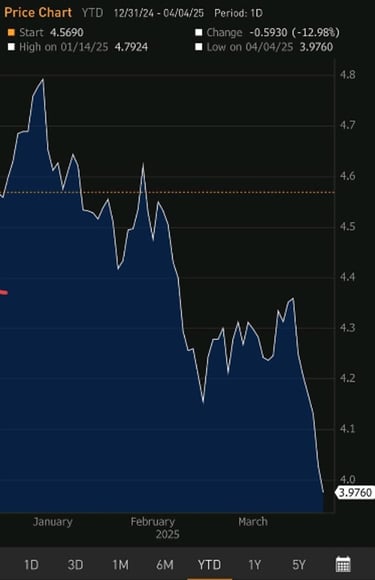Renato has over 30 years of experience in corporate management and Finance, starting from audit with Arthur Andersen in Italy, then moving internationally to consulting and then taking on various management responsibilities in corporate finance and investment fund management.
He has worked with Acqua Marcia, Amdhal, Banco di Roma, CDS Holding, O'Connors Capital, Natixis and many other companies and managed investment transactions, joint ventures and privatisations of real estate assets for over 30 billion euros.
Renato holds a degree in business administration and audit from University of Trieste and speaks fluently english, french and italian.


Renato Lavorato
Managing Partner


Alberto Mastrolilli
Partner




Paolo Rubino
Partner
Gianni Rossi
Partner
Alberto has over 30 years of experience in corporate finance risk management and project financing. He started his career in institutional audit with Arthur Andersen in Italy, then moved to France, Spain and Scandinavia for c_level position in the insurance and credit sector.
He worked worldwide with Atradius Credito y Caucion, Aon Italy, IMCI+ Group International and Metodo network with responsibility for capital management, credit rating, M&A, corporate restructuring, insurance brokerage.
Alberto holds a degree in economics from University of Rome and speaks fluently english, spanish and italian.
Paolo has over 30 years’ experience in the corporate environment, from marketing in the airline industry in Italy, then moving internationally to sales, corporate strategy and finance. Top management seniority in aviation, hotel's hospitality, energy and natural resources industries.
He worked with Alitalia, Air One, Air Bee, various aircraft lessors, Acea, Victoria Time Corporation, AST group acting, in many of those, in the apical positions. He has successfully managed in various context of turnaround and start up.
Paolo holds a degree in international law and economics and a MLE from the IUHEI of Geneve and speaks fluently english, french and italian.
Gianni has a solid operational background with over 30 years of work experience in aviation, global and banking sectors. He was CEO of Meridiana Airlines, Eurofly, Vice President of Olbia Airport, CFO of Airone Airlines and CFO of BNL BNP Paribas.
He is president and CEO of AssirecreGroup and Sardinia Sea Power, and professor at University of Messina. He was lecturer in aviation business at University of Milan and executive partner for SIP private hedge fund.
Giovanni holds a degree in Biochemistry and a MBA from the Polytechnic University of Milan and speaks fluently Italian and english.
Typewriter
Author Renato Lavorato
Short Pills With Focus on the RE Sector That is Pulling - February 2025
Investment Funds as Monetization and Development Instrument - February 2025
Introduction of Safe Harbour ruling for investment vehicles in Italy - March 2025
Author Gianni Rossi
Courtesy of:
Author Francesco Bruno
Short Pills With Focus on the RE Sector That is Pulling
by Renato Lavorato
Pretending that nothing is happening overseas (seen from the European shore), and above all, that these bizarre winds will stop blowing as soon as possible, let's take a look at what is happening in the sectors that in my opinion are hot at the moment:
Focus on Hospitality:
Italy's hospitality market is experiencing robust growth, driven by a resurgence in tourism and strategic investments.
Market Growth and Projections - In 2023, Italy welcomed approximately 275 million hotel nights and 86 million arrivals, nearly matching pre-pandemic levels. Looking ahead, the hospitality industry is projected to reach USD 10.01 billion in 2025, with an expected compound annual growth rate (CAGR) of 7.54% through 2030.
Investment Trends - The first half of 2024 saw over €600 million in hotel transactions, doubling the volume from the same period in 2023. Notably, Rome is leading in future hotel developments, with an estimated addition of 2,000 rooms over the next three years.
Regional Dynamics - Major cities like Milan and Rome continue to attract significant international visitors, while secondary cities such as Verona, Bologna, Turin, Naples, and Catania are gaining attention from investors seeking higher yields.
Challenges and Regulatory Measures - To manage overtourism, cities like Florence have implemented measures such as banning key boxes in historic centers and restricting loudspeakers for tour guides. Additionally, Italy has banned self check-ins for short-term rentals to enhance security, especially with the anticipated influx of travelers during the 2025 Holy Year. Overall, Italy's hospitality market is poised for continued growth, with strategic investments and regulatory measures shaping its future trajectory.
Dubai's hospitality market is experiencing significant growth, marked by increased visitor numbers, higher occupancy rates, and substantial investments in new hotel developments.
Visitor Growth and Occupancy Rates - In 2024, Dubai welcomed 18.72 million international visitors, a 9% increase from the previous year. The city's hotel sector achieved an average occupancy rate of 78.2%, up from 77.4% in 2023, indicating a strong recovery and sustained demand.
Revenue and Average Daily Rates - The first half of 2024 saw Dubai's hotel market demonstrate a notable recovery, with an average Revenue Per Available Room (RevPAR) growth of 4.7% compared to the same period last year. The upscale sector experienced the largest average growth of around 9.0% in RevPAR.
New Hotel Developments - The first half of 2024 witnessed the addition of approximately 2,700 new hotel rooms in Dubai, including 436 four-star rooms and 1,681 five-star rooms. This expansion reflects the city's commitment to accommodating the growing number of visitors and enhancing its hospitality offerings.
Market Outlook - The UAE's hospitality market is poised for continued growth, with forecasts indicating a valuation of USD 7 billion by 2026 and a 25% industry growth by 2030. Overall, Dubai's hospitality sector is thriving, driven by increased tourism, higher occupancy rates, and ongoing investments in new hotel developments.
To be noted, the UAE Ministry of Finance has published a Cabinet Decision introducing a top-up tax in line with the Organisation for Economic Co-operation and Development (OECD), on corporate and business taxation.
This is a top-up tax applicable to multinational companies with low-taxed income in the UAE with a minimum effective tax rate of 15%.
Europe's hospitality market is experiencing a robust recovery, marked by increased investment, rising occupancy rates, and a resurgence in tourism.
Investment Surge - In the first half of 2024, hotel transactions in Europe reached €10.6 billion, a 123% increase from the same period in 2023, indicating a strong rebound from previous downturns. Notably, Blackstone invested over €500 million in southern European hotels in the past year, acquiring properties like the Grand Hyatt Athens for €235 million.
Performance Indicators - December 2024 concluded with favorable performance indicators, including improved occupancy and average daily rates (ADR). However, growth was primarily driven by the upscale segment, with lower-tier categories showing relative weakness.
Regional Variations - Southern Europe, particularly Spain, Portugal, and Italy, is experiencing positive investment trends, with Spain and Portugal showing sustained growth and Italy turning more positive. Conversely, Western European countries like Germany, France, and the Netherlands are facing a downturn in investment sentiment.
Market Outlook - The European hospitality sector is poised for continued growth, driven by increased tourism and strategic investments. While challenges such as geopolitical uncertainties and economic fluctuations persist, the overall trajectory remains positive.
Luxembourg February 13th, 2025
A Costly Farewell to Italy's National Flag Carrier: Old Stories and the Same Problems
by Gianni Rossi
Once upon a time, there was an Italian dream—a dream of wings, blue skies, and a tricolor flag proudly emblazoned on airplanes. That dream was called Alitalia. Then came the night. From its ashes, in October 2021, ITA Airways was born, a state-owned airline promising to be everything Alitalia never was in deregulated skies: modern, efficient, and capable of flying without burdening taxpayers. But as often happens with bedtime stories, reality turned out to be quite different.
Three years later, with the recent green light from the EU for Lufthansa's entry, the fairy tale has ended. We now open the more bitter chapter of reality. The fleet is new, the livery is elegant, but the numbers—those ruthless arbiters of truth—tell a story of failure. Like Alitalia, ITA has failed to achieve economic sustainability. This chapter closes an era: the romantic dream of an Italian flag carrier, a symbol that for decades carried the tricolor across the world, now destined to become just another piece of a foreign group. A goodbye that feels inevitable but no less painful.
Taking Off, But with Engines Stalling - Yes, ITA has taken off. Planes fly, passengers board, tickets sell. But every day, the airline burns approximately €1 million. The five-year plan that in 2021 projected a €209 million profit by 2024 remains a distant mirage. Revenues this year will likely fall short by about €400 million, while balance sheets continue to be stained deep red. Even 2024 will be no exception, despite likely reliance on the same “creative accounting” practices seen over the last three years—better suited for fiction than for a textbook on prudent accounting.
And liquidity? By the end of June, it depended almost entirely on prepaid passenger tickets, a kind of advance on hopes for future flights. In three years, ITA has accumulated over €1.2 billion in operational cash outflows. In short, the airline seems to soar only in press releases and political speeches.
The EU and Its Peculiar Idea of "Discontinuity" - In 2021, the European Commission approved ITA's "discontinuity" from Alitalia with a rather creative interpretation of EU regulations. Today, with similar enthusiasm, it has authorized Lufthansa's entry, hailing the deal as a triumph of competition. The reality? Alitalia's strategic Linate slots—worth at least €800 million—were first transferred for free to ITA and will now partly be handed over to foreign airlines. And what about Italians? All that remains is the ITA livery with the Italian flag on the tail—a symbol at risk of becoming a fading memory of lost opportunities.
The Invisible Workers - This story isn't just about numbers but also people who pay the highest price. Over 2,000 former Alitalia employees, excluded from ITA's project, will lose all support by the end of 2024. Then there are the 2,000 Swissport workers whose jobs are at risk due to uncertainties about operational permits at Fiumicino. Thousands of families are left to face uncertainty in a country that, while professing its commitment to job security, often leaves it unfulfilled.
A Future Called Lufthansa - If ITA Airways is not currently grappling with the legal issue of continuity of operations, it owes this to the "reasonable certainty" of Lufthansa’s imminent intervention. By January 2025, the German giant will acquire a 41% stake and assume operational control through a €325 million investment— the only real hope for financial stabilization. ITA will become a new operational division of the Lufthansa Group, integrating into its multi-hub strategy.
However, with Rome Fiumicino, Lufthansa will face an entirely new challenge: boosting revenues in a highly competitive environment dominated by low-cost carriers—a stark contrast to the Group’s established hubs. While this is good news for ITA's future, it invites a bittersweet reflection: the original ITA project, with all its ambitions, has proven to be, as many analysts predicted, an expensive crash landing rather than a flight toward new horizons.
A Missing Strategic Plan - The ITA Airways story isn't just about an airline. It reflects a larger issue: the absence of a national strategic plan for the aviation sector. Over the past two decades, other European countries—Germany and France above all—have built networks, alliances, and investments to strengthen their national carriers. Italy, on the other hand, has wasted time with receiverships, political meddling, and shortsighted decisions, never seriously considering the role a national airline should play in the country’s economy.
The Final Coup de Théâtre - Thus, after 67 years of history, the Flag Carrier withdraws in a coup de théâtre worthy of the finest Italian tragedies. The Italian State has effectively given away:
- Goodwill, slots, and know-how accumulated over 64 years of Alitalia.
- The implicit guarantee for the largest fleet purchase ever made in Italy, exceeding €3 billion.
- Over €1.3 billion in non-refundable funds to support complete and free disposal.
As they say in aviation, “a landing isn’t successful if you can’t take off again.” Let’s hope Lufthansa succeeds where ITA and Alitalia failed. But for now, over the past 25 years, the only things that have truly taken off are missed opportunities and wasted money.
Dr. Gianni Rossi is Adjunct Professor of Air Transport Economics – University of Messina (UNIME)
Messina, November 30, 2024
Open, Closed or....Interval
by Renato Lavorato
Open, Closed, or...Interval? Interval funds are a type of mutual fund that is very similar in structure to closed-end funds (essentially funds that have a collection end date and no distribution until their scheduled liquidation) and that offer investors the option (but not the obligation) to periodically redeem a percentage of their shares at pre-established intervals.
Unlike traditional closed-end funds, whose shares are necessarily traded on the secondary market, interval fund shares must be purchased (new) or sold (existing shares) directly to the fund at the current net asset value (NAV) during the scheduled repurchase windows. For this reason, interval funds may have higher fees than other types of mutual funds, and generally require a more significant minimum investment on average, often between $10,000 and $25,000, with management costs that can reach the astronomical percentage of 3%.
The not extreme popularity of these funds has always confined them to a few amateurs but, in recent years, interval funds are recording significant growth for several reasons:
- Access to less liquid and more profitable investments: in fact, managers, less constrained by a random variation in liquidity, can include less liquid assets in the portfolio, such as private debt or investments in infrastructure, which can offer potentially higher returns than traditional investments.
- Optimized investor loyalty management: periodic repurchase windows encourage investors to maintain a longer time horizon, reducing the temptation to sell in response to short-term market fluctuations.
- Punctual valuation at the scheduled maturities: Unlike other closed-end funds, where the shares must be traded at a premium or discount, in interval funds transactions occur at net asset value, offering a more transparent valuation.
In a word, for investors with high income and little interest in savings management, interval funds can be an excellent diversification formula (provided that there is always someone to receive you at the interval date).
Investment funds as a support for business development
The use of investment funds represents an effective strategy for the monetization and valorization of real estate portfolios. Here are some highlights of how funds can be used in this context.
Real estate funds raise capital from various investors to acquire, manage and valorize real estate properties. By entrusting your portfolio to a fund, you monetize its value, you maintain, with the appropriate structuring, the investment line, and you benefit from professional management, access to institutional credit and economies of scale, optimizing returns and reducing the risks associated with direct management. Furthermore, real estate funds allow investors to participate in large-scale projects or in markets that would otherwise be inaccessible individually, thanks to the sharing of resources among the fund participants.
Finally, it is important to consider the easier management of liquidity for investors: some real estate funds, such as open-ended funds, offer greater liquidity than direct investment in real estate, allowing investors to enter and exit more easily and therefore manage their liquidity needs with flexibility without sacrificing management and development objectives.
With regard to returns, fund managers can implement enhancement strategies, such as restructuring or changing the intended use of properties, increasing their market value and, consequently, returns for investors, without neglecting the fact that in some jurisdictions, real estate funds enjoy preferential tax treatments, which can translate into advantages for both managers and investors, improving the overall efficiency of the investment. It goes without saying that investing in real estate funds also allows, above all, to diversify the portfolio, reducing exposure to the risk associated with individual assets. This diversification can include different types of properties (residential, commercial, industrial) and geographies, increasing return opportunities.
In conclusion, the integration of investment funds in real estate portfolio monetization strategies offers numerous advantages, including professional management, diversification, access to large-scale projects and potential tax benefits. In addition, the support, if not the integration of investment funds in the business model of companies, allows to significantly expand access to financial resources by ensuring a cyclical multiplier model. However, it is essential to carefully evaluate the specific characteristics of each fund and align them with the financial objectives and risk profile of the investor.
Luxembourg February 2025
WHEN AND HOW A LUX AIF CAN BENEFIT FROM WHT AND CGT EXEMPTION IN ITALY
by Francesco Bruno
Is a Luxembourg AIF - established in the form of a société en commandite simplifié - entitled to benefit from WHT exemption (normally applied at the rate of 26%) on dividends distributed from its participated ITACO?
The matter has been the subject of a request for a ruling vis-à-vis of the Italian Revenue Agency (answer no. 409/2023).
The applicant is a Luxembourg alternative investment fund (LUX AIF) established through a special limited partnership (SLP) or société en commandite spéciale (SCSp), whose general partner is a Luxembourg limited liability company (S.à rl.), pursuant to a deed of appointment by the respective general partner the Investment Manager is authorised from the domestic Regulator (CSSF), and supervised under the AIFM directive (2011/61/EU of the European Parliament and of the Council of 8 June 2011). Furthermore, the Fund satisfies the requirement of plurality of investors as it is structured, according to the indications provided with the provision of the Bank of Italy of 19 January 2015.
The answer: According to the Italian Revenue Agency, the LUX AIF is entitled to benefit from the WHT exemption on dividends distributed from the Italian participated company (ITACO). In detail, the WHT exemption regime referred to in paragraph 3 of art. 27 DPR 600/1973 applies to the shareholdings directly held by the LUX AIF. In addition to that, any sale of qualified shareholdings (letter c) paragraph 1, art. 67 DPR 917/1986) in ITACO does not trigger taxable capital gains pursuant to art. 1, paragraph 633, of the 2021 Italian budget law.
Documentation: To obtain the WHT exemption on dividends, in line with what it has already been clarified by the tax authorities in the response to the ruling published on 25 October 2019, no. 430, the LUX AIF must submit to the WHT Agent the following documents:
a) the self-certification attesting the establishment of the Fund in Luxembourg.
b) the self-certification attesting the Investment Manager's residence in Luxembourg.
c) copy of the certification issued by the CSSF, certifying the registration of the Investment Manager pursuant to the AIFM directive.
d) if the CSSF does not issue a certificate, any documentation suitable to demonstrate the exercise of the supervisory activity by the same CSSF.
The AIFM directive, continuing the path taken by the UCITS directive, ensures recognition throughout the EU of the authorizations and prudential supervision systems of each Member State. To set up and manage a harmonized UCITS or an AIF in a Member State, therefore, it is sufficient to issue the authorization and exercise supervision by the manager's home Member State only (“home country control”). The AIFM Directive does not regulate AIFs, which continue to be regulated and supervised at national level under the law of the State in which they are established.
As already specified in the response to the ruling published on 11 May 2021, n. 327, AIFs established in an EU country and whose Investment Manager is authorized there and subject to supervision pursuant to the AIFM directive, can benefit from the exemption regimes referred to in the aforementioned art. 27, paragraph 3 of DPR 600/1973, and art. 1, paragraph 633, of the budget law 2021, with reference to equity investments held directly in companies resident in Italy.
Historical Evolution of the Italian Legislation: Paragraph 3, art. 27 of DPR 600/1973 provides for the application of a WHT of 26% on dividends paid by ITA companies to non-resident subjects, without prejudice to the possibility of applying, where more favourable, the conventional rates in the presence of a Convention for the avoidance of double taxation stipulated between Italy and the State of residence of the recipient of the dividends.
Art. 1, paragraph 631, of the 2021 budget law, amended the aforementioned art. 27, paragraph 3 DPR 600/1973, adding, at the end, the following sentence: «The WHT referred to in the first sentence does not apply on profits paid to foreign collective investment undertakings (UCIs) compliant with directive 2009/65/EC of the European Parliament and of the Council of 13 July 2009, and with UCIs, not compliant with the aforementioned directive 2009/65/EC, whose manager is subject to forms of supervision in the foreign country in which it is established pursuant to Directive 2011/61/EU of the European Parliament and of the Council of 8 June 2011 established in the Member States of the EU and EEA Countries which allow for an adequate exchange of information".
The following paragraph 632 establishes that this amendment applies "to dividends received from the date of entry into force of this law", i.e. from 1 January 2021.
A similar exemption is provided for capital gains deriving from the sale of qualified participations, since paragraph 633 of art. 1 of the 2021 budget law establishes that «they do not contribute to forming the income the capital gains and capital losses referred to in letter c) of paragraph 1 of art. 67 DPR 22 December 1986, n. 917, starting from the date of entry into force of this law, by undertakings for collective investment (UCI) under foreign law or compliant with directive 2009/65/EC of the European Parliament and of the Council of 13 July 2009, and UCITS, not compliant with the aforementioned directive 2009/65/EC, whose manager is subject to forms of supervision in the foreign country in which it is established pursuant to directive 2011/61/EU of the European Parliament and of the Council of 8 June 2011, established in the Member States of the EU and in the EEA Countries which allow for an adequate exchange of information".
Luxembourg August 2023
Introduction of Safe Harbour ruling for investment vehicles in Italy
Introduction of Safe Harbour ruling for investment vehicles in Italy in order to ensure an adequate level of confidence for investments (Investment Management Exemption).
Summary extracted from the article “Investment Management Exemption under the lens of Assonime to stem possible disputes” published in “Il Fisco” number 18/2023 by Diego Avolio and Giovanni Barbagelata.
The 2023 Budget Law introduced an absolute presumption (safe harbour) to exclude the existence of a permanent establishment in Italy for non-resident investment vehicles, if the activities carried out by their managers fall within certain parameters. This innovation has raised interpretative questions, overcoming previous practices of the Revenue Agency.
Assonime has analyzed the issue, highlighting how the rule can guarantee greater tax certainty for foreign funds. However, critical issues remain, including the requirement of independence of the fund manager, who cannot have roles in the administrative bodies of the investment vehicle.
The legislation on permanent establishment, already amended in 2018 to comply with OECD standards (BEPS Action 7), distinguishes between a "material" permanent establishment (physical presence in Italy) and a "personal" permanent establishment (agent who concludes contracts on behalf of a non-resident company). The 2018 Budget Law lowered the threshold for considering a foreign company as subject to taxation in Italy, emphasizing the role of non-independent agents.
The 2023 safe harbour fits into this context, creating protection for foreign investment vehicles, provided that intermediaries act independently and are not closely related to the parent company. The question of the interpretation of the concept of "economic and legal independence" of agents remains open, with possible future legislative changes or bilateral treaties to align with OECD standards.
The paper discusses the interpretation of the tax rules regarding foreign investment vehicles and the independence of asset managers. Assonime advocates a broad interpretation that includes not only individual investment transactions, but the entire management activity, both for securities and real estate funds.
It is highlighted that the presumption of independence of the asset manager is subject to certain conditions, including the residence of the investment vehicle in a “white list country” and compliance with independence criteria that will be defined by an implementing decree. It underlines the need to clarify the concept of “plurality of investors” and to exclude from the ban on holding administrative positions the managers of asset managers who operate in private equity.
Furthermore, the issue of profit participation is addressed, with the limit of 25% to prevent the manager from assuming a role similar to that of an investor. Finally, the document addresses the risk of configuring a “material” permanent establishment in Italy for foreign funds, with the introduction of a safe harbour to avoid tax disputes. Assonime underlines the importance of adapting Italian legislation to the OECD guidelines to ensure clarity and legal certainty for operators in the sector.
Luxembourg March 25
Collateral evolution in digital transaction - Decentralized Finance (DeFi) is transforming the financial sector, particularly in how collateral is managed in digital transactions.
Built on blockchain technology, DeFi uses smart contracts to automate and secure collateral management, offering greater efficiency, transparency, and accessibility compared to traditional financial systems. Smart contracts streamline processes like collateral validation, margin calls, and liquidation, reducing errors, costs, and delays while providing real-time visibility for informed decision-making.
DeFi introduces innovations like over-collateralization, flash loans, and yield farming, enhancing capital efficiency and financial inclusion. Smart contracts ensure security and reliability, although careful design and audits are needed to prevent vulnerabilities. DeFi collateral systems utilize various digital assets and implement dynamic collateralization ratios to manage risk and market volatility.
The successful implementation of smart contracts requires technical considerations, including blockchain platform selection and network reliability. Integration with traditional financial systems is facilitated by standardized protocols, with best practices emerging to ensure reliability and interoperability.
The future of DeFi collateral management looks promising, with trends in cross-chain collateral, synthetic assets, and AI-driven risk assessment. Technological advancements in scalability and privacy will continue to enhance DeFi's potential. As institutional interest grows and regulatory frameworks evolve, DeFi is set to increasingly impact traditional finance, making the management of collateral through smart contracts a key factor in its success.
Luxembourg - March 2025
Decentralized Finance
No kids on the bridge
Recent US trade moves have shaken the global economy, but contrary to what we might expect, US government bond yields have recently fallen: on April 3, the 10-year Treasury yield fell to 4.06%, from 4.20% the day before.
This decline came after the US announced new import tariffs, which raised fears of a global recession and pushed investors towards assets considered safer, such as US government bonds. As a result, demand for these securities increased, causing yields to fall. (see chart)


At the same time, following the announcement, the value of the US dollar has suffered a significant decline: on April 3, 2025, the US dollar index (DXY), which measures the value of the dollar against a basket of six major currencies, fell to 101.34, a loss of around 2% and its steepest decline in two years, weakening against the euro to EUR 0.9048, from EUR 0.9201 the previous day. This decline in the dollar presumably reflects investors' concerns about the economic impact of the new tariffs, which could slow economic growth and increase inflation in the United States.
Now, in theory the weakening of the US dollar should push international holders of US government bonds to sell them, given the exchange risk, the loss on capital and negative future expectations, however we are witnessing an investor flight towards them evidently justified by quality, the possibility of rate cuts and expectations of accommodative policies.
In fact, the data show that foreign holdings of US Treasuries have remained relatively stable: as of January 2025, foreign investors held a total of $8.526 trillion in US Treasuries, unchanged from the previous month and up 7.2% from the previous year.
However, within this general picture, specific movements occurred: foreign private investors made net purchases of $59.2 billion in long-term securities, while foreign official institutions recorded net sales of $59.0 billion in the same period.
These data suggest that, despite currency fluctuations and economic concerns, overall demand for US Treasuries from foreign investors remains solid and the US bond market, at least for now, continues to be perceived as a safe haven, especially in times of global economic uncertainty.
Certainly, European government bonds could represent a valid alternative for investors, especially in a context of uncertainty on US Treasuries, offering i) lower exposure to the dollar, competitive interest rates (some Eurozone countries such as Italy and Greece offer higher yields than US Treasuries), ii) relative economic stability (the issuance of common EU bonds (e.g. Next Generation EU bonds) has strengthened the credibility of the European bond market) and iii) diversification. It is also worth noting that the EU has increased the issuance of common bonds in recent years (such as EU-Bonds linked to recovery plans), which offer an increasingly attractive alternative to Treasuries.
We could conclude that if investors are looking for safety and liquidity, US Treasuries remain the first choice, but if they want protection from exchange rate risk and diversification, European bonds can be a good alternative.
But something has changed. The arrogance of American trade policy towards Chinese products (especially cars) is irritating China, and the need for the latter to increase its commercial outlets towards alternative markets is out of question. Now, what is the largest, relatively stable market in the world, and also looking for new outlets?Europe. And how could China leverage Europe to negotiate new, stable and peaceful trade agreements? Could a repositioning of China on European treasuries significantly affects the attractiveness of these bonds? I think so.
China is one of the largest holders of US Treasuries, with about 775 billion dollars in securities at the end of January 2025, and a massive sale of Treasuries by China could push up yields, because lower demand implies lower prices and therefore higher yields. If China decided to increase its exposure to German Bunds, French OATs or Italian BTPs, these securities would become more attractive to other investors; more demand would mean lower yields and therefore cheaper financing for European governments and consequently a strengthening of the euro. Bingo.
Now, China has already started reducing its exposure to US Treasuries in recent years, preferring to diversify its reserves, however, the US Treasuries market is more liquid and safe than European bonds, so a drastic move is still unlikely, but American aggressiveness on trade could still push China to use Treasuries as a tool to put pressure on the US, even at the cost of damaging, at least temporarily, the value of its own reserves. The signal of change on the markets would be clear and remarkable.
In recent months, China has already shown signs of diversifying its reserves, gradually reducing exposure to US Treasuries. For example, in December 2024, Chinese holdings fell to $759 billion from $768.6 billion in November 2024. This trend indicates a possible strategy to reduce exposure to US debt, and furthermore, the recent escalation of trade tensions between the United States and China has led the latter to limit its companies' investments in the US (according to an article in the New York Post, China has blocked its companies from making investments in the United States in view of an escalation of the trade war). These measures could reflect a broader strategy to reduce economic dependence on the United States.
Now, it is clear that any significant repositioning could affect the attractiveness of US Treasuries, increasing yields to attract new investors and potentially weakening the dollar. The question is: how long could the dollar withstand continued and pronounced disruptions?
Determining the precise level at which the dollar could enter an irreversible depreciation spiral is complex, but there are some key factors that could signal a tipping point such as:
Psychological threshold in currency markets - The US dollar index (DXY), which measures the value of the dollar against a basket of major currencies, is currently around 101.34. A drop below 95 could increase market concerns, prompting investors and central banks to reduce exposure to the dollar; if the EUR/USD pair were to consistently break above 1.25-1.30, it could signal a structural loss of confidence in the dollar.
Flight from US Treasuries - If 10-year Treasury yields rise above 5.5%-6%, it would mean that investors are demanding a high risk premium to hold dollars; massive selling by China, Japan or sovereign wealth funds could accelerate the depreciation.
Inflation and Fed Expectations - If US inflation returns above 5%, the Fed may have to raise rates, but at the risk of destabilizing the debt market, and an aggressive hike that could temporarily support the dollar would hurt the US economy, creating a vicious cycle of mistrust.
At this point, an acceleration in the use of the euro, yuan or cryptocurrencies for global trade could reduce demand for dollars, and if countries like Saudi Arabia start pricing oil in yuan or euros significantly, demand for dollars could collapse; the dollar could gradually decline without problems to a DXY of 95-90, but a fall below 85, combined with a flight from Treasuries and an acceleration in the use of alternatives, could trigger an irreversible crisis of confidence such as even a rapid and uncontrolled depreciation could render ineffective emergency policies as interventions by the Fed or international agreements to stabilize the market.
We have seen monetary crises and defaults, and we will always see them, but it has always been the preparation, determination and foresight of the politicians in office that have determined their breadth and duration. Can we trust, today, in US policy? But above all the real question is: how long can this political "perturbation" last? Here we are witnessing global geopolitical shifts in terms of volume and speed never seen before. Movements that either are immediately put under control, or will evolve irremediably towards new balances, where the American empire will probably no longer exist.
Luxembourg - April 25
